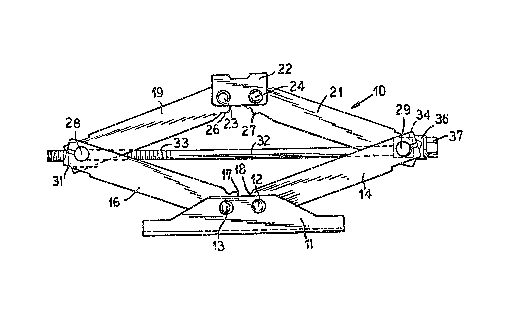Some of the information on this Web page has been provided by external sources. The Government of Canada is not responsible for the accuracy, reliability or currency of the information supplied by external sources. Users wishing to rely upon this information should consult directly with the source of the information. Content provided by external sources is not subject to official languages, privacy and accessibility requirements.
Any discrepancies in the text and image of the Claims and Abstract are due to differing posting times. Text of the Claims and Abstract are posted:
| (12) Patent: | (11) CA 2098856 |
|---|---|
| (54) English Title: | IMPROVED OPEN END CONSTRUCTION FOR JACK |
| (54) French Title: | OUTIL DE LEVAGE A EXTREMITE LIBRE AMELIOREE |
| Status: | Expired and beyond the Period of Reversal |
| (51) International Patent Classification (IPC): |
|
|---|---|
| (72) Inventors : |
|
| (73) Owners : |
|
| (71) Applicants : |
|
| (74) Agent: | CASSAN MACLEAN |
| (74) Associate agent: | |
| (45) Issued: | 1999-01-19 |
| (22) Filed Date: | 1993-06-21 |
| (41) Open to Public Inspection: | 1994-09-18 |
| Examination requested: | 1995-11-29 |
| Availability of licence: | N/A |
| Dedicated to the Public: | N/A |
| (25) Language of filing: | English |
| Patent Cooperation Treaty (PCT): | No |
|---|
| (30) Application Priority Data: | ||||||
|---|---|---|---|---|---|---|
|
An improved open end construction for jacks which
provides for tabs which extend at right angles to the side
surfaces of the channel members so as to allow pivot pins to
be received in the open ends after which the tabs are bent so
that they lie in the plane of the side surfaces of the channel
members so as to lock the pivot pin in the ends of the channel
assembly. Also, partial flanges can be formed about the
openings in the ends of the channel members so as to provide
bearing surfaces for the pivot pins.
Une amélioration est apportée à une terminaison ouverte pour un vérin. Cette terminaison est constituée par des languettes orientées à angle droit par rapport aux côtés des canaux, permettant d'insérer une cheville dans cette terminaison. la suite de cette opération, on replie les languettes de façon qu'elles soient orientées dans le plan des côtés des canaux, de sorte que la cheville soit immobilisée dans la terminaison. On peut également monter des anneaux partiels aux ouvertures des terminaisons des canaux afin de fournir des surfaces d'appui aux chevilles.
Note: Claims are shown in the official language in which they were submitted.
Note: Descriptions are shown in the official language in which they were submitted.

2024-08-01:As part of the Next Generation Patents (NGP) transition, the Canadian Patents Database (CPD) now contains a more detailed Event History, which replicates the Event Log of our new back-office solution.
Please note that "Inactive:" events refers to events no longer in use in our new back-office solution.
For a clearer understanding of the status of the application/patent presented on this page, the site Disclaimer , as well as the definitions for Patent , Event History , Maintenance Fee and Payment History should be consulted.
| Description | Date |
|---|---|
| Inactive: IPC from MCD | 2006-03-11 |
| Time Limit for Reversal Expired | 2002-06-21 |
| Letter Sent | 2001-06-21 |
| Grant by Issuance | 1999-01-19 |
| Inactive: Final fee received | 1998-10-05 |
| Pre-grant | 1998-10-05 |
| Notice of Allowance is Issued | 1998-08-27 |
| Notice of Allowance is Issued | 1998-08-27 |
| Letter Sent | 1998-08-27 |
| Inactive: Status info is complete as of Log entry date | 1998-08-20 |
| Inactive: Application prosecuted on TS as of Log entry date | 1998-08-20 |
| Inactive: Approved for allowance (AFA) | 1998-06-25 |
| Request for Examination Requirements Determined Compliant | 1995-11-29 |
| All Requirements for Examination Determined Compliant | 1995-11-29 |
| Application Published (Open to Public Inspection) | 1994-09-18 |
There is no abandonment history.
The last payment was received on 1998-06-02
Note : If the full payment has not been received on or before the date indicated, a further fee may be required which may be one of the following
Patent fees are adjusted on the 1st of January every year. The amounts above are the current amounts if received by December 31 of the current year.
Please refer to the CIPO
Patent Fees
web page to see all current fee amounts.
| Fee Type | Anniversary Year | Due Date | Paid Date |
|---|---|---|---|
| MF (application, 4th anniv.) - standard | 04 | 1997-06-23 | 1997-06-16 |
| MF (application, 5th anniv.) - standard | 05 | 1998-06-22 | 1998-06-02 |
| Final fee - standard | 1998-10-05 | ||
| MF (patent, 6th anniv.) - standard | 1999-06-21 | 1999-05-12 | |
| MF (patent, 7th anniv.) - standard | 2000-06-21 | 2000-06-19 |
Note: Records showing the ownership history in alphabetical order.
| Current Owners on Record |
|---|
| UNIVERSAL TOOL & STAMPING COMPANY, INC. |
| Past Owners on Record |
|---|
| DARRYL L. ENGEL |
| JOHN R. SCOVILLE |